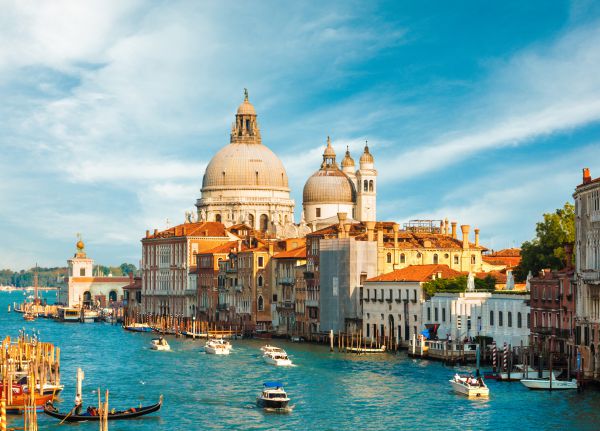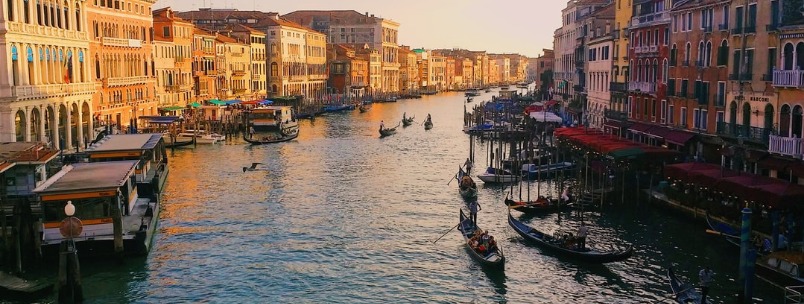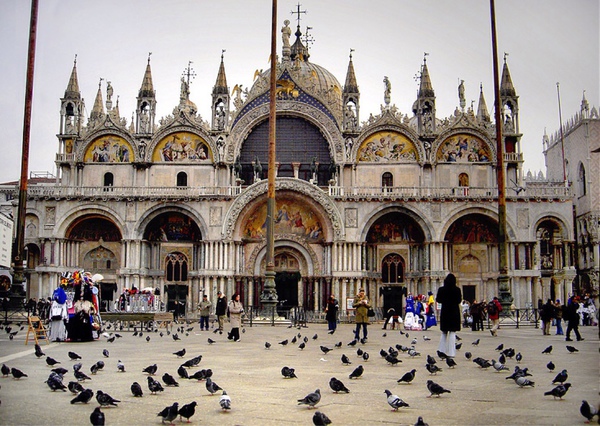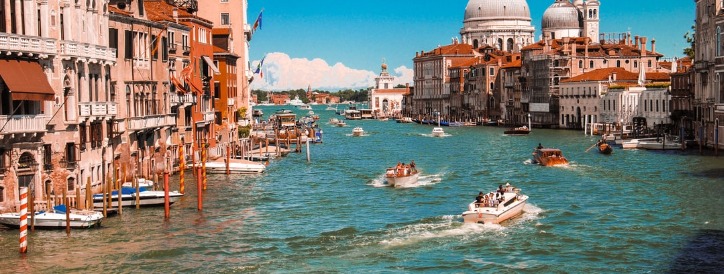Venice, also known as the queen of the sea is one of the most spectacular tourist destinations in the world. It is a city located in the north eastern side of Italy, and consists of about 118 islands connected by bridges and separated by canals. The scenic views are spectacular and can take your breath away. The city also offers a myriad of uniquely designed artworks.

If you only had one place to visit in Italy I would recommend Venice. This city has a rich and wonderful past and history. The way Venice was built and the way the water systems work is fascinating and worth the visit. Venice was founded more than 1,500 years ago on over one hundred islands. Venice is linked by over a hundred canals and several hundred bridges. It is fun to walk the small back alleys and streets like the natives do.
When you visit Venice, you will find that the city is hustling and bustling. The water is alive just like a freeway back home except these are boats, both small and big. Venice is a water city and it lives and dies by the water. There are many hotels in Venice and Venice hotels can come in many shapes and sizes, although, most will be expensive. There are quite a few that are fairly priced and easy to get to. The more luxury type of hotel in Venice commands top dollar as a world-class type of hotel.
Venice Hotels
The City of Venice has some of the finest interior design in the world. The city boasts some of the most sophisticated design in Europe, the architecture is simply out of this world. Keep an eye our for; colorful chandeliers made of merino glass; and furniture such as the “lace povera”, which incorporate images of social life. Also look out for the girandole mirrors which are some of the finest in Europe.
You will find that you can find and book a hotel that will meet almost any budget. You might not be as close to the main canal as some, but, the hotels will all be nice and well cared for in Venice. It is wise to book your hotel before you arrive in Venice in case there is a large group or something is going on in the town. There is a hotel booking kiosk at the rail station and they usually can help you book and find a hotel if you arrive without a reservation.
Dining in Venice
No shortage of easting or drinking in Venice. The cafes and restaurants will serve world-class meals in minutes. It will be hard to choose which cafe or restaurant you want to eat next. It is fun to walk and explore this town and the more you walk the more you see. Some of the better-known areas of Venice tend to be saturated with tourists, but it is very easy to get off the beaten path very quickly and enjoy a peaceful and relaxing walk through the old Venice.
Getting Around Venice
Since Venice is made up of islands and shallow lagoons, most of the transport is via boat and foot. This makes the city rather unique. A classic boat in Venice is known as gondola which is used by tourists and locals to showcase the attractions.

Venice constitutes many islands, the canals in between the islands encourage the nautical culture which is the main source of income in the island. The most amazing things about the waterways are the canal mazes, which have more than 400 foot bridges that facilitate people’s movement from one island to the other.
Water buses are the main form of transportation other than walking in Venice. There are private water taxis but I caution that taking a private water taxi is expensive. The gondolas are a great way to spend some time and how can you visit Venice without taking at least one gondolas ride. The view you get from the water is unique and you will see a different Venice from a gondola.
What’s the Allure?
Venice constitutes many islands, the canals in between the islands encourage the nautical culture which is the main source of income in the island. The most amazing things about the waterways are the canal mazes, which have more than 400 foot bridges that facilitate people’s movement from one island to the other.
Venice boasts grand architecture, romantic canals, sensuous art and an old-world charm that still resembles the city it was over 500 centuries ago. Visitors explore the winding streets and regal palazzi (palaces) much the same way they did in ancient times – on foot or by water traffic. Despite its infamous floods and the unfortunate resulting decay, this enchanting city continues to seduce admirers with its top-notch cuisine and trademark interiors. This strong dedication to its creative ancestry is one of the main reasons Venice remains one of the most visited destinations in Europe.
Points of Interest
Venice is not just a city to be visited; it is one to be experienced. This can be achieved (to a certain degree) by getting lost in its ancient alleyways or simply by taking a touristy but delightful gondola ride – at least once. Follow this with a leisurely exploration of Venice’s many art galleries and monuments and you will find yourself transported back in time.
Although there are dozens of places to choose from, some worth noting include the lively Piazza San Marco (St. Mark’s Square) which features musicians, fantastic al fresco dining and the general hustle and bustle that comes with any popular attraction. Another “must-see” is the authentic open-air Rialto Market for some of the freshest produce, dairy, and fruit one could ever sample. Art lovers should consider a stop at Peggy Guggenheim’s impressive collection of artwork from around the world.
St. Mark’s Basilica & Campanile
This beautiful structure is located in St. Mark’s Square. Behind the soaring 30-story Campanile, you can see the incredible and massive basilica. These two structures are probably the most popular tourist attractions in the city. St. Mark’s Basilica & Campanile were both constructed in the 9th century, but over the years they had been rebuilt and embellished. San Marco Basilica features design mixes between Byzantine and Gothic architecture style.

Rialto Bridge
For more than three hundred years, Rialto Bridge had been the only way to cross the Grand Canal on foot. These days, this bridge is one of the four bridges spanning the beautiful Grand Canal. Rialto Bridge was designed by Antonio da Ponte and was used to replace a wooden bridge that collapsed. This beautiful bridge was completed in 1591 and became one of the architectural icons of Venice.
San Giorgio Maggiore
San Giorgio Maggiore is highly known as homing the 16th-century church that bears the same name. This beautiful place is a small island that is situated across the lagoon from St. Mark’s Square. San Giorgio Maggiore was designed by the famous Renaissance architect Andrea Palladio.
Activities
Venice boasts many musical festivals, cultural, artistic and cinematic production and also hosts major international conferences. St Mark’s Basilica, the Grand Canal, the Piazza San Marco and Lido di Venezia, are some of the most popular tourist sites.
The main districts of Venice are known as “Sestieri” and also offer travelers plenty to see and enjoy. If you have the time and the inclination to do so, visit some of the other surrounding areas (118 islands in all) including the beach zone called Lido di Venezia or the brightly- colored architecture found at neighboring Burano.
Although there is certainly a lot to discover in Venice both by foot and by boat, it is seldom the same experience when the sun goes down and as it comes up again. To illustrate; taking a cruise at night means experiencing the canals and beautifully lit palazzos in a completely different perspective. On the other hand, if you take a walk in the early morning before the market opens and the tourists overwhelm the squares, you will witness the semi-private preparations and daily routines of the street performers and gondoliers at their most candid.
Why We Love it
The multitude of artisans found in Venice from the world of art, food, music, and design is remarkable. Perhaps even more astonishing is the fact that all of this glorious creativity allows one to forgive the crowds of visitors at every turn as well as the damp odors caused by heavy rainfall and flooding. Venice is just that remarkable.
Sightseeing in Venice
Nobody arrives in Venice and sees the city for the first time. Depicted and described so often that its image has become part of the European collective consciousness, Venice can initially create the slightly anticlimactic feeling that everything looks exactly as it should. The water-lapped palaces along the Canal Grande are just as the brochure photographs made them out to be, Piazza San Marco does indeed look as perfect as a film set, and the panorama across the water from the Palazzo Ducale is precise as Canaletto painted it. The sense of familiarity soon fades, however, as details of the scene begin to catch the attention – an ancient carving high on a wall, a boat being maneuvered around an impossible corner, a tiny shop in a dilapidated building, a waterlogged basement. And the longer one looks, the stranger and more intriguing Venice becomes.
Founded fifteen hundred years ago on a cluster of mudflats in the center of the lagoon, Venice rose to become Europe’s main trading post between the West and the East, and at its height controlled an empire that spread north to the Dolomites and over the sea as far as Cyprus. As its wealth increased and its population grew, the fabric of the city grew ever denser. Very few parts of the hundred or so islets that compose the historic center are not built up, and very few of its closely-knit streets bear no sign of the city’s long lineage. Even in the most insignificant alleyway, you might find fragments of a medieval building embedded in the wall of a house like fossil remains lodged in a cliff face.
The melancholic air of the place is in part a product of the discrepancy between the grandeur of its history and what the city has become. In the heyday of the Venetian Republic, some 200,000 people lived in Venice, not far short of three times its present population. Merchants from Germany, Greece, Turkey and a host of other countries maintained warehouses here; transactions in the banks and bazaars of the Rialto dictated the value of commodities all over the continent; in the dockyards of the Arsenale the workforce was so vast that a warship could be built and fitted out in a single day; and the Piazza San Marco was perpetually thronged with people here to set up business deals or report to the Republic’s government. Nowadays it’s no longer a living metropolis but rather the embodiment of a fabulous past, dependent for its survival largely on the people who come to marvel at its relics.
The monuments which draw the largest crowds are the Basilica di San Marco – the mausoleum of the city’s patron saint – and the Palazzo Ducale – the home of the doge and all the governing councils. Certainly, these are the most dramatic structures in the city: the first a mosaic-clad emblem of Venice’s Byzantine origins, the second perhaps the finest of all secular Gothic buildings. Every parish rewards exploration, though – a roll-call of the churches worth visiting would feature over fifty names, and a list of the important paintings and sculptures they contain would be twice as long. Two of the distinctively Venetian institutions known as the Scuole retain some of the outstanding examples of Italian Renaissance art – the Scuola di San Rocco, with its dozens of pictures by Tintoretto, and the Scuola di San Giorgio Degli Schiavoni, decorated with a gorgeous sequence by Carpaccio.
Although many of the city’s treasures remain in the buildings for which they were created, a sizeable number have been removed to one or other of Venice’s museums. The one that should not be missed is the Accademia, an assembly of Venetian painting that consists of virtually nothing but masterpieces; other prominent collections include the Museum of eighteenth-century art in the Ca’ Rezzonico and the Museo Correr, the civic museum of Venice – but again, a comprehensive list would fill a page.
Then, of course, there’s the inexhaustible spectacle of the streets themselves, of the majestic and sometimes decrepit palaces, of the hemmed-in squares where much of the social life of the city is conducted, of the sunlit courtyards that suddenly open up at the end of an unpromising passageway. The cultural heritage preserved in the museums and churches is a source of endless fascination, but you should discard your itineraries for a day and just wander – the anonymous parts of Venice reveal as much of the city’s essence as the highlighted attractions. Equally indispensable for a full understanding of Venice’s way of life and development are expeditions to the northern and southern islands of the lagoon, where the incursions of the tourist industry are on the whole less obtrusive.
Venice’s hinterland – the Veneto – is historically and economically one of Italy’s most important regions. Its major cities – Padua , Vicenza, and Verona – are all covered in the guide, along with many of the smaller towns located between the lagoon and the mountains to the north. Although rock-bottom hotel prices are rare in the affluent Veneto, the cost of accommodation on the mainland is appreciably lower than in Venice itself, and to get the most out of the less accessible sights of the Veneto it’s definitely necessary to base yourself for a day or two somewhere other than Venice – perhaps in the northern town of Belluno or in the more central Castelfranco.
